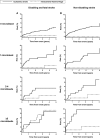Antiplatelet Treatment After Transient Ischemic Attack and Ischemic Stroke in Patients With Cerebral Microbleeds in 2 Large Cohorts and an Updated Systematic Review
- PMID: 29748422
- PMCID: PMC5976229
- DOI: 10.1161/STROKEAHA.117.020104
Antiplatelet Treatment After Transient Ischemic Attack and Ischemic Stroke in Patients With Cerebral Microbleeds in 2 Large Cohorts and an Updated Systematic Review
Abstract
Background and purpose: In patients with transient ischemic attack/ischemic stroke, microbleed burden predicts intracerebral hemorrhage (ICH), and ischemic stroke, but implications for antiplatelet treatment are uncertain. Previous cohort studies have had insufficient follow-up to assess the time course of risks, have not stratified risks by antithrombotic use, and have not reported extracranial bleeds or functional outcome of ICH versus ischemic stroke.
Methods: In 2 independent prospective cohorts with transient ischemic attack/ischemic stroke (Oxford Vascular Study/mainly white; University of Hong Kong/mainly Chinese), antiplatelet treatment was started routinely irrespective of microbleed burden. Risks, time course and outcome of ICH, extracranial bleeds, and recurrent ischemic events were determined and stratified by microbleed burden (0 versus 1, 2-4, and ≥5), adjusting for age, sex, and vascular risk factors.
Results: Microbleeds were more frequent in the Chinese cohort (450 of 1003 versus 165 of 1080; P<0.0001), but risk associations were similar during 7433 patient-years of follow-up. Among 1811 patients on antiplatelet drugs, risk of major extracranial bleeds was unrelated to microbleed burden (Ptrend=0.87), but the 5-year risk of ICH was steeply related (Ptrend<0.0001), with 11 of 15 (73%) of ICH in 140 of 1811 (7.7%) patients with ≥5 microbleeds. However, risk of ischemic stroke also increased with microbleed burden (Ptrend=0.013), such that risk of ischemic stroke and coronary events exceeded ICH and major extracranial bleeds during the first year, even among patients with ≥5 microbleeds (11.6% versus 3.9%). However, this ratio changed over time, with risk of hemorrhage (11.2%) matching that of ischemic events (12.0%) after 1 year. Moreover, whereas the association between microbleed burden and risk of ischemic stroke was due mainly to nondisabling events (Ptrend=0.007), the association with ICH was accounted for (Ptrend<0.0001) by disabling/fatal events (≥5 microbleeds: 82% disabling/fatal ICH versus 40% disabling/fatal ischemic stroke; P=0.035).
Conclusions: In white and Chinese patients with ≥5 microbleeds, withholding antiplatelet drugs during the first year after transient ischemic attack/ischemic stroke may be inappropriate. However, the risk of ICH may outweigh any benefit thereafter.
Keywords: cerebral small vessel disease; magnetic resonance imaging; stroke; transient ischemic attack.
© 2018 The Authors.
Figures




Comment in
-
Response by Lau and Rothwell to Letter Regarding Article, "Antiplatelet treatment after transient ischemic attack and ischemic stroke in patients with cerebral microbleeds in 2 large cohorts".Stroke. 2018 Sep;49(9):e293. doi: 10.1161/STROKEAHA.118.022659. Epub 2018 Aug 27. Stroke. 2018. PMID: 30214094 Free PMC article. No abstract available.
-
Letter by Saber Regarding Article, "Antiplatelet Treatment After Transient Ischemic Attack and Ischemic Stroke in Patients With Cerebral Microbleeds in 2 Large Cohorts and an Updated Systematic Review".Stroke. 2018 Sep;49(9):e292. doi: 10.1161/STROKEAHA.118.022429. Stroke. 2018. PMID: 30355007 No abstract available.
References
-
- Cordonnier C, Al-Shahi Salman R, Wardlaw J. Spontaneous brain microbleeds: systematic review, subgroup analyses and standards for study design and reporting. Brain. 2007;130:1988–2003. - PubMed
-
- Fisher M. Cerebral microbleeds: where are we now? Neurology. 2014;83:1304–1305. doi: 10.1212/WNL.0000000000000871. - PubMed
-
- van Veluw SJ, Biessels GJ, Klijn CJ, Rozemuller AJ. Heterogeneous histopathology of cortical microbleeds in cerebral amyloid angiopathy. Neurology. 2016;86:867–871. doi: 10.1212/WNL.0000000000002419. - PubMed
-
- Lovelock CE, Cordonnier C, Naka H, Al-Shahi Salman R, Sudlow CL, Sorimachi T, et al. Edinburgh Stroke Study Group. Antithrombotic drug use, cerebral microbleeds, and intracerebral hemorrhage: a systematic review of published and unpublished studies. Stroke. 2010;41:1222–1228. doi: 10.1161/STROKEAHA.109.572594. - PubMed
-
- Charidimou A, Kakar P, Fox Z, Werring DJ. Cerebral microbleeds and recurrent stroke risk: systematic review and meta-analysis of prospective ischemic stroke and transient ischemic attack cohorts. Stroke. 2013;44:995–1001. doi: 10.1161/STROKEAHA.111.000038. - PubMed
Publication types
MeSH terms
Substances
Grants and funding
LinkOut - more resources
Full Text Sources
Other Literature Sources
Medical

